Mapping Cognitive Oncology: A Decade of Trends and Research Fronts
Abstract
1. Introduction
2. Methods
2.1. Search
2.2. Selection Criteria
2.3. Data Extraction and Software
2.4. Bibliometric Analysis
3. Results
3.1. Included Documents
3.2. Bibliometric Performance Analysis
3.3. Science Mapping
3.3.1. Co-Authorship Analysis
3.3.2. Bibliographic Coupling Analysis
3.3.3. Co-Citation Analysis
3.3.4. Co-Occurrence Analysis
4. Discussion
4.1. Summary of Key Findings
4.2. Interpretation of Thematic Clusters
4.3. Current Trends and Emerging Research Themes
- -
- Precision cognitive oncology, integrating biomarkers, genetic profiles, and neuroimaging signatures for individualized risk assessment and rehabilitation planning.
- -
- Longitudinal, multimodal studies capturing the dynamic trajectory of CRCI across cancer types, treatments, and survivorship phases.
- -
- Digital cognitive monitoring through computerized assessment and telehealth delivery to increase accessibility.
- -
- Holistic survivorship care models embedding cognitive health alongside physical, emotional, and social wellbeing.
4.4. Methodological Considerations and Limitations
4.5. Directions for Future Research
5. Conclusions
Supplementary Materials
Author Contributions
Funding
Institutional Review Board Statement
Informed Consent Statement
Data Availability Statement
Acknowledgments
Conflicts of Interest
References
- Ma, X.; Deng, K.; Sun, Y.; Wu, M. Research Trends on Cancer Neuroscience: A Bibliometric and Visualized Analysis. Front. Neurosci. 2024, 18, 1408306. [Google Scholar] [CrossRef]
- Megari, K. Language Impairment among Patients with Different Types of Cancer. Comparison with Healthy Adults. Breast Cancer Res. Treat. 2020, 184, 779–782. [Google Scholar] [CrossRef]
- Megari, K. Instrumental Activities of Daily Living and Neuropsychological Functioning among Patients with Different Types of Cancer. Eur. J. Neurol. 2021, 28, 66–70. [Google Scholar] [CrossRef] [PubMed]
- Tsiakiri, A.; Plakias, S.; Kokkotis, C.; Vlotinou, P.; Kyriazidou, S.; Giarmatzis, G.; Kallivoulos, S.; Terzoudi, A.; Tsiptsios, D.; Merai, S.; et al. Instrumental Activities of Daily Living in Neurocognitive Disorders: Determinants and Clinical Implications for Health Promotion. Brain Sci. 2025, 15, 417. [Google Scholar] [CrossRef] [PubMed]
- Megari, K. Neuropsychological Functioning among Patients with Different Types of Cancer: Postchemotherapy Cognitive Impairment and Implications for Rehabilitation. Neuropsychiatrie 2021, 35, 92–97. [Google Scholar] [CrossRef]
- Megari, K.; Thomaidou, E.; Kougioumtzis, G.A.; Theodoratou, M.; Katsarou, D.; Karlafti, E.; Didaggelos, M.; Paramythiotis, D.; Argyriadou, E. What Do Cancer Surgery and Orthopedic Surgery Elderly Patients Have in Common? A Long-Term Postoperative Cognitive Dysfunction in Orthopedic and Cancer Patients Original Research. Neurosci. Insights 2024, 19, 26331055231220906. [Google Scholar] [CrossRef]
- Plakias, S. Review Articles on Soccer Performance Analysis: A Bibliometric Analysis of Current Trends and Emerging Themes. Sports 2025, 13, 131. [Google Scholar] [CrossRef]
- Passas, I. Bibliometric Analysis: The Main Steps. Encyclopedia 2024, 4, 1014–1025. [Google Scholar] [CrossRef]
- Pamboris, G.M.; Plakias, S.; Tsiakiri, A.; Karakitsiou, G.; Bebeletsi, P.; Vadikolias, K.; Aggelousis, N.; Tsiptsios, D.; Christidi, F. Physical Therapy in Neurorehabilitation with an Emphasis on Sports: A Bibliometric Analysis and Narrative Review. Sports 2024, 12, 276. [Google Scholar] [CrossRef]
- Tsiakiri, A.; Plakias, S.; Karakitsiou, G.; Nikova, A.; Christidi, F.; Kokkotis, C.; Giarmatzis, G.; Tsakni, G.; Katsouri, I.-G.; Dimitrios, S.; et al. Mapping the Landscape of Biomechanics Research in Stroke Neurorehabilitation: A Bibliometric Perspective. Biomechanics 2024, 4, 664–684. [Google Scholar] [CrossRef]
- Tsiara, A.A.; Plakias, S.; Kokkotis, C.; Veneri, A.; Mina, M.A.; Tsiakiri, A.; Kitmeridou, S.; Christidi, F.; Gourgoulis, E.; Doskas, T.; et al. Artificial Intelligence in the Diagnosis of Neurological Diseases Using Biomechanical and Gait Analysis Data: A Scopus-Based Bibliometric Analysis. Neurol. Int. 2025, 17, 45. [Google Scholar] [CrossRef]
- Plakias, S.; Karakitsiou, G.; Armatas, V.; Kasioura, C.; Moustou, O.; Tsiakiri, A. Performance Profiling in Sports: A Scopus-Based Bibliometric and Narrative Analysis. Insight Sports Sci. 2025, 7, 728. [Google Scholar] [CrossRef]
- Moral-Muñoz, J.A.; Herrera-Viedma, E.; Santisteban-Espejo, A.; Cobo, M.J. Software Tools for Conducting Bibliometric Analysis in Science: An up-to-Date Review. Prof. Inf. 2020, 29, e290103. [Google Scholar] [CrossRef]
- Van Eck, N.J.; Waltman, L. Software Survey: VOSviewer, a Computer Program for Bibliometric Mapping. Scientometrics 2010, 84, 523–538. [Google Scholar] [CrossRef]
- Becker, L.T.; Gould, E.M. Microsoft Power BI: Extending Excel to Manipulate, Analyze, and Visualize Diverse Data. Ser. Rev. 2019, 45, 184–188. [Google Scholar] [CrossRef]
- Donthu, N.; Kumar, S.; Mukherjee, D.; Pandey, N.; Lim, W.M. How to Conduct a Bibliometric Analysis: An Overview and Guidelines. J. Bus. Res. 2021, 133, 285–296. [Google Scholar] [CrossRef]
- Ellegaard, O. The Application of Bibliometric Analysis: Disciplinary and User Aspects. Scientometrics 2018, 116, 181–202. [Google Scholar] [CrossRef]
- Van Eck, N.J.; Waltman, L. VOSviewer Manual; Version 1.6.13; Centre for Science and Technology Studies (CWTS), Leiden University: Leiden, The Netherlands, 2019; Available online: https://www.vosviewer.com/documentation/Manual_VOSviewer_1.6.13.pdf (accessed on 1 May 2025).
- Visualizing Bibliometric Networks. Available online: https://scispace.com/papers/visualizing-bibliometric-networks-22tv7965er (accessed on 19 June 2025).
- Alexander, J.F.; Mahalingam, R.; Seua, A.V.; Wu, S.; Arroyo, L.D.; Hörbelt, T.; Schedlowski, M.; Blanco, E.; Kavelaars, A.; Heijnen, C.J. Targeting the Meningeal Compartment to Resolve Chemobrain and Neuropathy via Nasal Delivery of Functionalized Mitochondria. Adv. Healthc. Mater. 2022, 11, 2102153. [Google Scholar] [CrossRef]
- Datta, A.; Roy, S. Social Emotion Recognition, Social Functioning and Suicidal Behaviour in Breast Cancer Patients in India. Gulf J. Oncol. 2022, 1, 31–38. [Google Scholar]
- Fortes, G.N.; Fortes, M.F.; Fortes, M.N.; Gomes, F.C.; Seelaendar, M.C.L.; de Pinho, A.M.S.; de Jesus, J.D.C.R.; Otoch, J.P. Mood, Anxiety, and Cognitive Alterations in Cancer Patients. J. Surg. Oncol. 2024, 130, 965–973. [Google Scholar] [CrossRef]
- Giffard, B.; Perrotin, A.; Allain, P.; Dayan, J.; Eustache, F.; Grellard, J.-M.; Faveyrial, A.; Joly, F.; Lange, M. The Role of Metamemory on Cognitive Complaints in Cancer Patients. Brain Behav. 2020, 10, e01545. [Google Scholar] [CrossRef] [PubMed]
- Madison, A.A.; Andridge, R.; Kantaras, A.H.; Renna, M.E.; Bennett, J.M.; Alfano, C.M.; Povoski, S.P.; Agnese, D.M.; Lustberg, M.; Wesolowski, R.; et al. Depression, Inflammation, and Intestinal Permeability: Associations with Subjective and Objective Cognitive Functioning throughout Breast Cancer Survivorship. Cancers 2023, 15, 4414. [Google Scholar] [CrossRef]
- Sanchez, L.; Fernandez, N.; Calle, A.P.; Ladera, V.; Casado, I.; Bayon, E.; Garcia, I.; Sahagun, A.M. Assessing the Expression of Emotions in Breast Cancer Survivors during the Time of Recovery: Perspective from Focus Groups. Int. J. Environ. Res. Public Health 2022, 19, 9672. [Google Scholar] [CrossRef]
- Schoenberg, P.; Wulff-Burchfield, E.; Schlundt, D.; Bonnet, K.; Dietrich, M.; Murphy, B. Qualitative Classification of Late Systemic Symptoms in Head and Neck Cancer Survivors. Cancers 2024, 16, 2106. [Google Scholar] [CrossRef]
- Sharpley, C.F.; Bitsika, V.; Christie, D.R.H. Variability in Depressive Symptoms of Cognitive Deficit and Cognitive Bias During the First 2 Years After Diagnosis in Australian Men with Prostate Cancer. Am. J. Men’s Health 2016, 10, 6–13. [Google Scholar] [CrossRef]
- Sleight, A.G.; Myers, J.S.; Cook-Wiens, G.; Baynes, R.; Jo, M.-Y.; Asher, A. Loneliness as a Risk Factor for Cancer-Related Cognitive Impairment: A Secondary Data Analysis from the Haze Study. Disabil. Rehabil. 2023, 45, 2325–2328. [Google Scholar] [CrossRef]
- Small, B.J.; Jim, H.S.L.; Eisel, S.L.; Jacobsen, P.B.; Scott, S.B. Cognitive Performance of Breast Cancer Survivors in Daily Life: Role of Fatigue and Depressed Mood. Psycho-Oncology 2019, 28, 2174–2180. [Google Scholar] [CrossRef]
- Wang, L.; Ding, Y.; Zhang, Y.; Chen, Y.; Xue, M.; Wang, X. The Association between Neuropsychological Impairment, Self-Perceived Cognitive Deficit, Symptoms, and Health Related Quality of Life in Newly Diagnosed Ovarian Cancer Patients. Asia-Pac. J. Oncol. Nurs. 2024, 11, 100447. [Google Scholar] [CrossRef]
- West, T.; Cavallero, C.; Ceccherini, R.; Foladore, S.; Generali, D.; Versace, F.; Scaggiante, B. Impact of Psychosocial, Behavioral and Lifestyle Factors on Subjective Cognitive Complaints and Perceived Quality of Life in a Large Cohort of Italian Breast Cancer Patients. Front. Psychol. 2022, 13, 1015573. [Google Scholar] [CrossRef] [PubMed]
- Allen, B.D.; Acharya, M.M.; Lu, C.; Giedzinski, E.; Chmielewski, N.N.; Quach, D.; Hefferan, M.; Johe, K.K.; Limoli, C.L. Remediation of Radiation-Induced Cognitive Dysfunction through Oral Administration of the Neuroprotective Compound NSI-189. Radiat. Res. 2018, 189, 345–353. [Google Scholar] [CrossRef] [PubMed]
- Bai, X.; Zheng, J.; Zhang, B.; Luo, Y. Cognitive Dysfunction and Neurophysiologic Mechanism of Breast Cancer Patients Undergoing Chemotherapy Based on Resting State Functional Magnetic Resonance Imaging. World Neurosurg. 2021, 149, 406–412. [Google Scholar] [CrossRef] [PubMed]
- Chen, V.C.-H.; Lin, T.-Y.; Yeh, D.-C.; Chai, J.-W.; Weng, J.-C. Functional and Structural Connectome Features for Machine Learning Chemo-Brain Prediction in Women Treated for Breast Cancer with Chemotherapy. Brain Sci. 2020, 10, 851. [Google Scholar] [CrossRef]
- Durán-Gómez, N.; López-Jurado, C.F.; Nadal-Delgado, M.; Pérez-Civantos, D.; Guerrero-Martín, J.; Cáceres, M.C. Chemotherapy-Related Cognitive Impairment in Patients with Breast Cancer Based on Functional Assessment and NIRS Analysis. J. Clin. Med. 2022, 11, 2363. [Google Scholar] [CrossRef]
- Elia, C.; de Girolamo, L.; Clarisse, B.; Galin, M.; Rehel, S.; Clochon, P.; Doidy, F.; Segobin, S.; Viader, F.; Naveau, M.; et al. Effects of Sleep Disturbances and Circadian Rhythms Modifications on Cognition in Breast Cancer Women before and after Adjuvant Chemotherapy: The ICANSLEEP-1 Protocol. BMC Cancer 2023, 23, 1178. [Google Scholar] [CrossRef]
- Finke, C.; Bartels, F.; Lütt, A.; Prüss, H.; Harms, L. High Prevalence of Neuronal Surface Autoantibodies Associated with Cognitive Deficits in Cancer Patients. J. Neurol. 2017, 264, 1968–1977. [Google Scholar] [CrossRef]
- Gaynor, A.M.; Ahsan, A.; Jung, D.; Schofield, E.; Li, Y.; Ryan, E.; Ahles, T.A.; Root, J.C. Novel Computerized Neurocognitive Test Battery Is Sensitive to Cancer-Related Cognitive Deficits in Survivors. J. Cancer Surviv. 2024, 18, 466–478. [Google Scholar] [CrossRef]
- Guo, K.; Liu, X.; Gong, X.; Li, A.; Liu, Y.; Li, X.; Zhou, D.; Hong, Z. Autoimmune Encephalitis with mGluR5 Antibodies: A Case Series from China and Review of the Literature. Front. Immunol. 2023, 14, 1146536. [Google Scholar] [CrossRef]
- Guo, P.; Xing, X.; Wu, K.; Wang, Y.; Chen, Z.; Cao, L.; Li, X.; Li, N. 1H-MRS Study of Hippocampus in Advanced Prostate Cancer Patients: Relationship between Hippocampal Secondary Damage and Cognitive Disorder Following Combined Androgen Blockade Therapy. PLoS ONE 2025, 20, e0323323. [Google Scholar] [CrossRef] [PubMed]
- Hermelink, K. Chemotherapy and Cognitive Function in Breast Cancer Patients: The so-Called Chemo Brain. J. Natl. Cancer Inst. Monogr. 2015, 2015, 67–69. [Google Scholar] [CrossRef]
- Jung, M.S.; Zhang, M.; Askren, M.K.; Berman, M.G.; Peltier, S.; Hayes, D.F.; Therrien, B.; Reuter-Lorenz, P.A.; Cimprich, B. Cognitive Dysfunction and Symptom Burden in Women Treated for Breast Cancer: A Prospective Behavioral and fMRI Analysis. Brain Imaging Behav. 2017, 11, 86–97. [Google Scholar] [CrossRef] [PubMed]
- Jung, M.S.; Visovatti, M.; Kim, M.; Cha, K.; Dlamini, N.; Cui, X. Cognitive Impairment in Women Newly Diagnosed with Thyroid Cancer before Treatment. Support. Care Cancer 2022, 30, 8959–8967. [Google Scholar] [CrossRef]
- Jung, W.H.; Chun, M.; Kim, N.H. Structural Brain Changes and Associated Self-Perceived Cognitive Deficits in Chemotherapy-Exposed Patients with Breast Cancer: A Longitudinal T1 and DTI Study. Curr. Psychol. 2024, 43, 34306–34318. [Google Scholar] [CrossRef]
- Kam, J.W.Y.; Brenner, C.A.; Handy, T.C.; Boyd, L.A.; Liu-Ambrose, T.; Lim, H.J.; Hayden, S.; Campbell, K.L. Sustained Attention Abnormalities in Breast Cancer Survivors with Cognitive Deficits Post Chemotherapy: An Electrophysiological Study. Clin. Neurophysiol. 2016, 127, 369–378. [Google Scholar] [CrossRef]
- Li, T.-Y.; Chen, V.C.-H.; Yeh, D.-C.; Huang, S.-L.; Chen, C.-N.; Chai, J.-W.; Chen, C.C.-C.; Weng, J.-C. Investigation of Chemotherapy-Induced Brain Structural Alterations in Breast Cancer Patients with Generalized q-Sampling MRI and Graph Theoretical Analysis. BMC Cancer 2018, 18, 1211. [Google Scholar] [CrossRef]
- Li, W.; Zhao, J.; Ding, K.; Chao, H.H.; Li, C.-S.R.; Cheng, H.; Shen, L. Catechol-O-Methyltransferase Gene Polymorphisms and the Risk of Chemotherapy-Induced Prospective Memory Impairment in Breast Cancer Patients with Varying Tumor Hormonal Receptor Expression. Med. Sci. Monit. 2020, 26, e923567. [Google Scholar] [CrossRef] [PubMed]
- Mo, C.; Lin, H.; Fu, F.; Lin, L.; Zhang, J.; Huang, M.; Wang, C.; Xue, Y.; Duan, Q.; Lin, W.; et al. Chemotherapy-Induced Changes of Cerebral Activity in Restingstate Functional Magnetic Resonance Imaging and Cerebral White Matter in Diffusion Tensor Imaging. Oncotarget 2017, 8, 81273–81284. [Google Scholar] [CrossRef] [PubMed]
- Perrier, J.; Viard, A.; Levy, C.; Morel, N.; Allouache, D.; Noal, S.; Joly, F.; Eustache, F.; Giffard, B. Longitudinal Investigation of Cognitive Deficits in Breast Cancer Patients and Their Gray Matter Correlates: Impact of Education Level. Brain Imaging Behav. 2020, 14, 226–241. [Google Scholar] [CrossRef] [PubMed]
- Piccirillo, J.F.; Hardin, F.M.; Nicklaus, J.; Kallogjeri, D.; Wilson, M.; Ma, C.X.; Coalson, R.S.; Shimony, J.; Schlaggar, B.L. Cognitive Impairment after Chemotherapy Related to Atypical Network Architecture for Executive Control. Oncology 2015, 88, 360–368. [Google Scholar] [CrossRef]
- Popp, I.; Rau, A.; Kellner, E.; Reisert, M.; Fennell, J.T.; Rothe, T.; Nieder, C.; Urbach, H.; Egger, K.; Grosu, A.L.; et al. Hippocampus-Avoidance Whole-Brain Radiation Therapy Is Efficient in the Long-Term Preservation of Hippocampal Volume. Front. Oncol. 2021, 11, 714709. [Google Scholar] [CrossRef]
- Ren, W.-T.; Li, Y.-X.; Wang, K.; Gao, L.; Yi, J.-L.; Huang, X.-D.; Luo, J.-W.; Wu, R.-Y.; Yang, Y.; Wang, J.-Y.; et al. Cerebral Functional Abnormalities in Patients with Nasopharyngeal Carcinoma after Radiotherapy: An Observational Magnetic Resonance Resting-State Study. Chin. Med. J. 2019, 132, 1563–1571. [Google Scholar] [CrossRef]
- Shen, C.-Y.; Tsai, Y.-H.; Chen, V.C.-H.; Chou, M.-C.; McIntyre, R.S.; Weng, J.-C. Comparison of Functional Dorsal Attention Network Alterations in Breast Cancer Survivors before and after Chemotherapy. Medicine 2021, 100, e27018. [Google Scholar] [CrossRef]
- van Grinsven, E.E.; Cialdella, F.; Verhoeff, J.J.C.; Philippens, M.E.P.; van Zandvoort, M.J.E. Different Profiles of Neurocognitive Functioning in Patients with Brain Metastases Prior to Brain Radiotherapy. Psycho-Oncology 2023, 32, 1752–1761. [Google Scholar] [CrossRef]
- Wang, C.; Zhao, Y.; Wang, L.; Pan, S.; Liu, Y.; Li, S.; Wang, D. C-Phycocyanin Mitigates Cognitive Impairment in Doxorubicin-Induced Chemobrain: Impact on Neuroinflammation, Oxidative Stress, and Brain Mitochondrial and Synaptic Alterations. Neurochem. Res. 2021, 46, 149–158. [Google Scholar] [CrossRef]
- Wang, J.; Zhang, H.; Augenreich, M.; Martinez-Lemus A, L.; Liu, Z.; Kang, X.; Lu, B.; Chang, H.-M.; Yeh, E.T.H.; Cata, J.; et al. Microglia-Mediated Synaptic Dysfunction Contributes to Chemotherapy-Related Cognitive Impairment. J. Neurochem. 2025, 169, e70024. [Google Scholar] [CrossRef] [PubMed]
- Barberis, M.; Poisson, I.; Prévost-Tarabon, C.; Letrange, S.; Froelich, S.; Thirion, B.; Mandonnet, E. Verbal Fluency Predicts Work Resumption after Awake Surgery in Low-Grade Glioma Patients. Acta Neurochir. 2024, 166, 88. [Google Scholar] [CrossRef]
- Buunk, A.M.; Gerritsen, M.J.J.; Jeltema, H.-R.; Wagemakers, M.; Metzemaekers, J.D.M.; Groen, R.J.M.; Spikman, J.M. Emotion Recognition in Patients with Low-Grade Glioma before and after Surgery. Brain Sci. 2022, 12, 1259. [Google Scholar] [CrossRef]
- Capo, G.; Skrap, M.; Guarracin, I.; Isola, M.; Battistella, C.; Ius, T.; Tomasino, B. Cognitive Functions in Repeated Glioma Surgery. Cancers 2020, 12, 1077. [Google Scholar] [CrossRef]
- Cochereau, J.; Herbet, G.; Duffau, H. Patients with Incidental WHO Grade II Glioma Frequently Suffer from Neuropsychological Disturbances. Acta Neurochir. 2016, 158, 305–312. [Google Scholar] [CrossRef]
- De Baene, W.; Jansma, M.J.; Schouwenaars, I.T.; Rutten, G.-J.M.; Sitskoorn, M.M. Task-Evoked Reconfiguration of the Fronto-Parietal Network Is Associated with Cognitive Performance in Brain Tumor Patients. Brain Imaging Behav. 2020, 14, 2351–2366. [Google Scholar] [CrossRef] [PubMed]
- Incekara, F.; Satoer, D.; Visch-Brink, E.; Vincent, A.; Smits, M. Changes in Language White Matter Tract Microarchitecture Associated with Cognitive Deficits in Patients with Presumed Low-Grade Glioma. J. Neurosurg. 2019, 130, 1538–1546. [Google Scholar] [CrossRef] [PubMed]
- Lang, S.; Gaxiola-Valdez, I.; Opoku-Darko, M.; Partlo, L.A.; Goodyear, B.G.; Kelly, J.J.P.; Federico, P. Functional Connectivity in Frontoparietal Network: Indicator of Preoperative Cognitive Function and Cognitive Outcome Following Surgery in Patients with Glioma. World Neurosurg. 2017, 105, 913–922.e2. [Google Scholar] [CrossRef]
- Mann, C.; Conradi, N.; Neuhaus, E.; Konczalla, J.; Freiman, T.M.; Spyrantis, A.; Weber, K.; Harter, P.; Rosenow, F.; Strzelczyk, A.; et al. Early Epilepsy Surgery in Benign Cerebral Tumors: Avoid Your ‘Low-Grade’ Becoming a ‘Long-Term’ Epilepsy-Associated Tumor. J. Clin. Med. 2022, 11, 5892. [Google Scholar] [CrossRef]
- Ng, S.; Lemaitre, A.-L.; Moritz-Gasser, S.; Herbet, G.; Duffau, H. Recurrent Low-Grade Gliomas: Does Reoperation Affect Neurocognitive Functioning? Neurosurgery 2022, 90, 221–232. [Google Scholar] [CrossRef]
- Racine, C.A.; Li, J.; Molinaro, A.M.; Butowski, N.; Berger, M.S. Neurocognitive Function in Newly Diagnosed Low-Grade Glioma Patients Undergoing Surgical Resection with Awake Mapping Techniques. Neurosurgery 2015, 77, 371–379. [Google Scholar] [CrossRef]
- Rijnen, S.J.M.; Meskal, I.; Bakker, M.; De Baene, W.; Rutten, G.-J.M.; Gehring, K.; Sitskoorn, M.M. Cognitive Outcomes in Meningioma Patients Undergoing Surgery: Individual Changes over Time and Predictors of Late Cognitive Functioning. Neuro-Oncology 2019, 21, 911–922. [Google Scholar] [CrossRef]
- Rimmer, B.; Balla, M.; Dutton, L.; Williams, S.; Araújo-Soares, V.; Gallagher, P.; Finch, T.; Lewis, J.; Burns, R.; Menger, F.; et al. Barriers and Facilitators to Self-Management in People Living with a Lower-Grade Glioma. J. Cancer Surviv. 2024. [Google Scholar] [CrossRef]
- Schouwenaars, I.T.; de Dreu, M.J.; Rutten, G.-J.M.; Ramsey, N.F.; Jansma, J.M. Cognitive Brain Activity before and after Surgery in Meningioma Patients. Eur. J. Neurosci. 2024, 60, 3759–3771. [Google Scholar] [CrossRef] [PubMed]
- Tymowski, M.; Kaspera, W.; Metta-Pieszka, J.; Zarudzki, Ł.; Ładziński, P. Neuropsychological Assessment of Patients Undergoing Surgery Due to Low-Grade Glioma Involving the Supplementary Motor Area. Clin. Neurol. Neurosurg. 2018, 175, 1–8. [Google Scholar] [CrossRef]
- Xie, M.-G.; Qiao, J.; Wang, X.; Zhou, J.; Guan, Y.; Liu, C.; Zhao, M.; Li, T.; Luan, G. The Cognitive Functions and Seizure Outcomes of Patients with Low-Grade Epilepsy-Associated Neuroepithelial Tumors. J. Neuro-Oncol. 2022, 160, 1–12. [Google Scholar] [CrossRef]
- Ahmeti, H.; Caliebe, A.; Röcken, C.; Jansen, O.; Mehdorn, M.H.; Synowitz, M. Impact of Peritumoral Brain Edema on Pre- and Postoperative Clinical Conditions and on Long-Term Outcomes in Patients with Intracranial Meningiomas. Eur. J. Med. Res. 2023, 28, 40. [Google Scholar] [CrossRef]
- Barbaret, C.; Delgado-Guay, M.O.; Sanchez, S.; Brosse, C.; Ruer, M.; Rhondali, W.; Monsarrat, L.; Michaud, P.; Schott, A.M.; Bruera, E.; et al. Inequalities in Financial Distress, Symptoms, and Quality of Life Among Patients with Advanced Cancer in France and the U.S. Oncologist 2019, 24, 1121–1127. [Google Scholar] [CrossRef]
- Cali, R.J.; Nephew, B.C.; Moore, C.M.; Chumachenko, S.; Sala, A.C.; Cintron, B.; Luciano, C.; King, J.A.; Hooper, S.R.; Giardiello, F.M.; et al. Altered Neural Networks and Cognition in a Hereditary Colon Cancer. IBRO Neurosci. Rep. 2021, 11, 137–143. [Google Scholar] [CrossRef]
- Couderc, A.-L.; Tomasini, P.; Greillier, L.; Nouguerède, E.; Rey, D.; Montegut, C.; Thomas, P.-A.; Barlesi, F.; Villani, P. Functional Status in Older Patients with Lung Cancer: An Observational Cohort Study. Support. Care Cancer 2022, 30, 3817–3827. [Google Scholar] [CrossRef] [PubMed]
- Ihrig, A.; Pernt, P.M.; Zschäbitz, S.; Huber, J.; Friederich, H.-C.; Bugaj, T.J.; Maatouk, I. Neurocognitive Effects of Androgen Deprivation Therapy and New Hormonal Agents in a Sample of Patients with Metastatic Prostate Cancer. Int. Urol. Nephrol. 2023, 55, 2733–2739. [Google Scholar] [CrossRef] [PubMed]
- Kurita, G.P.; Sandvad, M.; Lundorff, L.; De Mattos-Pimenta, C.A.; Hojsted, J.; Sjogren, P. Assessment of Cognitive Function in Patients with Metastatic Cancer: Are We Using the Right Tools? Palliat. Support. Care 2018, 16, 80–89. [Google Scholar] [CrossRef] [PubMed]
- Lu, X.-Y.; Chen, M.; Chen, D.-H.; Li, Y.; Liu, P.-T.; Liu, Y. Remifentanil on T Lymphocytes, Cognitive Function and Inflammatory Cytokines of Patients Undergoing Radical Surgery for Cervical Cancer. Eur. Rev. Med. Pharmacol. Sci. 2018, 22, 2854–2859. [Google Scholar] [CrossRef]
- Ma, Y.; Liu, N.; Wang, Y.; Zhang, A.; Zhu, Z.; Zhang, Z.; Li, Y.; Jian, G.; Fu, G.; Dong, M.; et al. Cognitive Adverse Events in Patients with Lung Cancer Treated with Checkpoint Inhibitor Monotherapy: A Propensity Score-Matched Analysis. eClinicalMedicine 2023, 59, 101987. [Google Scholar] [CrossRef]
- Meskal, I.; Gehring, K.; van der Linden, S.D.; Rutten, G.-J.M.; Sitskoorn, M.M. Cognitive Improvement in Meningioma Patients after Surgery: Clinical Relevance of Computerized Testing. J. Neuro-Oncol. 2015, 121, 617–625. [Google Scholar] [CrossRef]
- Overcash, J.; Perry, M. Cognitive Screening: Using the Clock-Drawing Test to Assess for Preexisting Deficits in Older Women Diagnosed with Breast Cancer. Clin. J. Oncol. Nurs. 2017, 21, 489–498. [Google Scholar] [CrossRef]
- Pravettoni, G.; Dell’Osso, B.; Bocci, T.; Cortese, F.; Ferrucci, R.; Lampis, V.; Rosci, C.; Priori, A. Psychiatric, Behavioral, and Cognitive Disorders in Patients with Extracranial Cancers. CNS Spectr. 2018, 23, 388–401. [Google Scholar] [CrossRef]
- Schiff, D.; Lee, E.Q.; Nayak, L.; Norden, A.D.; Reardon, D.A.; Wen, P.Y. Medical Management of Brain Tumors and the Sequelae of Treatment. Neuro-Oncology 2015, 17, 488–504. [Google Scholar] [CrossRef]
- Skeie, B.S.; Eide, G.E.; Flatebø, M.; Heggdal, J.I.; Larsen, E.; Bragstad, S.; Pedersen, P.-H.; Enger, P.Ø. Quality of Life Is Maintained Using Gamma Knife Radiosurgery: A Prospective Study of a Brain Metastases Patient Cohort. J. Neurosurg. 2017, 126, 708–725. [Google Scholar] [CrossRef]
- Smith, T.M.; Wang, W. Comparison of a Standard Computer-Assisted Cognitive Training Program to a Music Enhanced Program: A Mixed Methods Study. Cancer Rep. 2021, 4, e1325. [Google Scholar] [CrossRef]
- Stapleton, S.; Darlington, A.-S.E.; De Bono, J.S.; Wiseman, T. What Is the Impact of Targeted Therapies given within Phase i Trials on the Cognitive Function of Patients with Advanced Cancer: A Mixed-Methods Exploratory Study Conducted in an Early Clinical Trials Unit. BMJ Open 2022, 12, e050590. [Google Scholar] [CrossRef]
- Van Dyk, K.; Hunter, A.M.; Ercoli, L.; Petersen, L.; Leuchter, A.F.; Ganz, P.A. Evaluating Cognitive Complaints in Breast Cancer Survivors with the FACT-Cog and Quantitative Electroencephalography. Breast Cancer Res. Treat. 2017, 166, 157–166. [Google Scholar] [CrossRef] [PubMed]
- van Nieuwenhuizen, D.; Douw, L.; Klein, M.; Peerdeman, S.M.; Heimans, J.J.; Reijneveld, J.C.; Stam, C.J.; Hillebrand, A. Cognitive Functioning and Functional Brain Networks in Postoperative WHO Grade I Meningioma Patients. J. Neuro-Oncol. 2018, 140, 605–613. [Google Scholar] [CrossRef]
- Vance, D.E.; Frank, J.S.; Bail, J.; Triebel, K.L.; Niccolai, L.M.; Gerstenecker, A.; Meneses, K. Interventions for Cognitive Deficits in Breast Cancer Survivors Treated with Chemotherapy. Cancer Nurs. 2017, 40, E11–E27. [Google Scholar] [CrossRef]
- Voon, N.S.; Manan, H.A.; Yahya, N. Remote Assessment of Cognition and Quality of Life Following Radiotherapy for Nasopharyngeal Carcinoma: Deep-Learning-Based Predictive Models and MRI Correlates. J. Cancer Surviv. 2024, 18, 1297–1308. [Google Scholar] [CrossRef]
- Yao, C.; Rich, J.B.; Tirona, K.; Bernstein, L.J. Intraindividual Variability in Reaction Time before and after Neoadjuvant Chemotherapy in Women Diagnosed with Breast Cancer. Psycho-Oncology 2017, 26, 2261–2268. [Google Scholar] [CrossRef] [PubMed]
- Zheng, Y.; Zhao, J.; Shi, Y.; Gui, Z.; Xu, C.; Wu, Q.; Zhu, L.; Wang, Z.; Zhang, H.; He, L. Impact of Menopausal Status on Cognitive Function in Female Papillary Thyroid Carcinoma Patients: A Longitudinal Propensity Score Matched Study. BMC Women’s Health 2024, 24, 642. [Google Scholar] [CrossRef]
- Dalboni da Rocha, J.L.; Zou Stinnett, P.; Scoggins, M.A.; McAfee, S.S.; Conklin, H.M.; Gajjar, A.; Sitaram, R. Functional MRI Assessment of Brain Activity Patterns Associated with Reading in Medulloblastoma Survivors. Brain Sci. 2024, 14, 904. [Google Scholar] [CrossRef]
- Fayette, D.; Juríčková, V.; Kozák, T.; Mociková, H.; Gaherová, L.; Fajnerová, I.; Horáček, J. Cognitive Impairment Associated with Hodgkin’s Lymphoma and Chemotherapy. Neurosci. Lett. 2023, 797, 137082. [Google Scholar] [CrossRef]
- Juríčková, V.; Fayette, D.; Jonáš, J.; Fajnerová, I.; Kozák, T.; Horáček, J. Pretreatment Cancer-Related Cognitive Impairment in Hodgkin Lymphoma Patients. Curr. Oncol. 2023, 30, 9028–9038. [Google Scholar] [CrossRef] [PubMed]
- Fayette, D.; Juríčková, V.; Fajnerová, I.; Horáček, J.; Kozák, T. The Effect of Chemotherapy Treatment on Cognitive Impairment and Clinical Symptoms in Hodgkin Lymphoma Patients. Cancers 2025, 17, 1488. [Google Scholar] [CrossRef]
- Friedrich, M.; Filss, C.P.; Lohmann, P.; Mottaghy, F.M.; Stoffels, G.; Weiss Lucas, C.; Ruge, M.I.; Shah, N.J.; Caspers, S.; Langen, K.-J.; et al. Structural Connectome-Based Predictive Modeling of Cognitive Deficits in Treated Glioma Patients. Neuro-Oncol. Adv. 2024, 6, vdad151. [Google Scholar] [CrossRef]
- Sinha, R.; Masina, R.; Morales, C.; Burton, K.; Wan, Y.; Joannides, A.; Mair, R.J.; Morris, R.C.; Santarius, T.; Manly, T.; et al. A Prospective Study of Longitudinal Risks of Cognitive Deficit for People Undergoing Glioblastoma Surgery Using a Tablet Computer Cognition Testing Battery: Towards Personalized Understanding of Risks to Cognitive Function. J. Personal. Med. 2023, 13, 278. [Google Scholar] [CrossRef]
- Kleinknecht, K.R.; Bierend, M.; Keim, L.-M.; Bartels, F.; Lampit, A.; Finke, C. Computerized Cognitive Training Improves Cognitive Function in Primary Breast Cancer Survivors. npj Breast Cancer 2024, 10, 85. [Google Scholar] [CrossRef] [PubMed]
- Dwek, M.-R.; Newman, S.P.; Brini, S.; Holder, P.; Machesney, M.; Propper, D.; Rixon, L.R.; Hirani, S.P.; Hurt, C.S. The Impact of Chemotherapy on Cognitive Performance Post-Surgery in Patients with Colorectal Cancer: A Prospective Cohort Study. Psycho-Oncology 2023, 32, 1057–1066. [Google Scholar] [CrossRef]

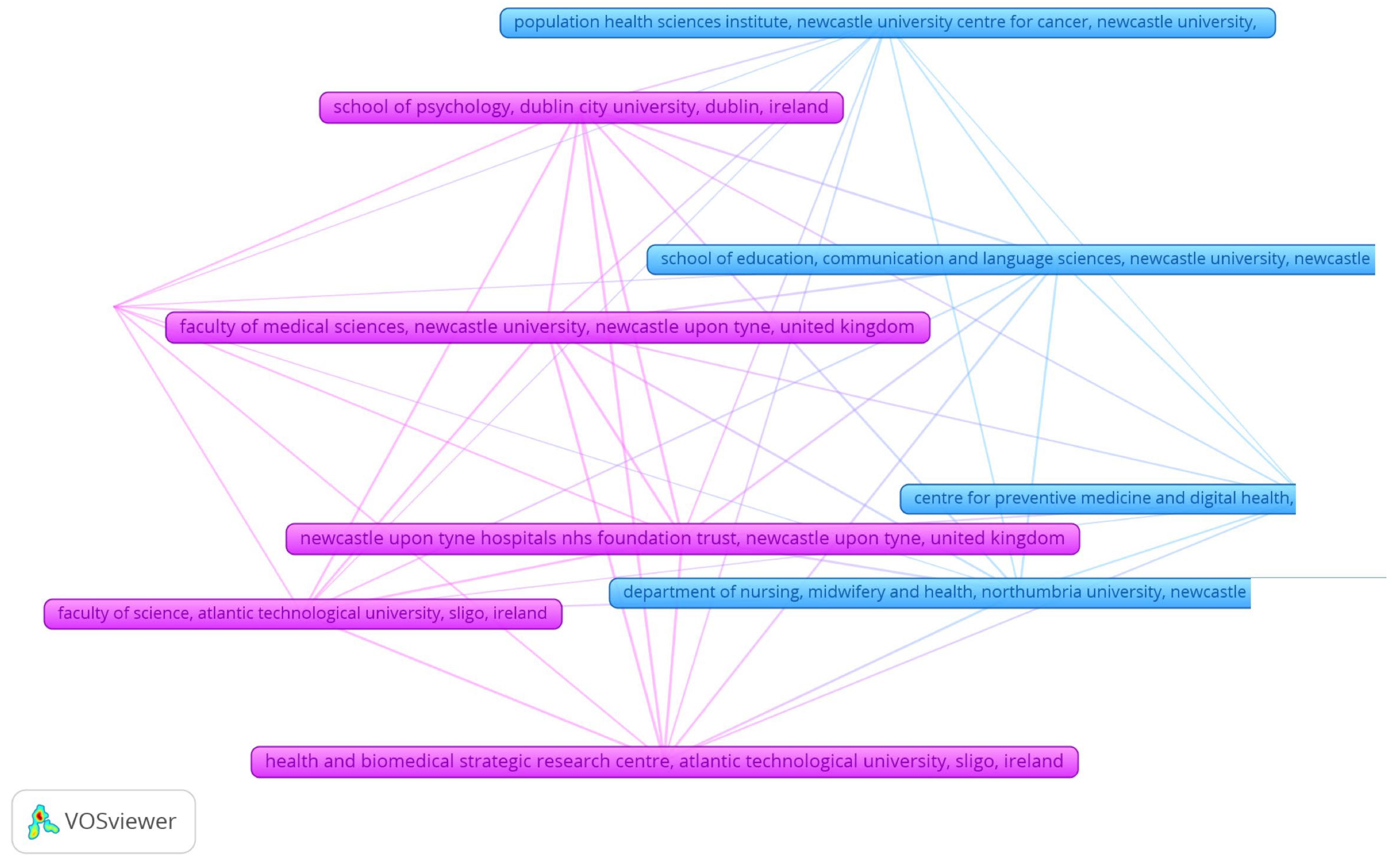
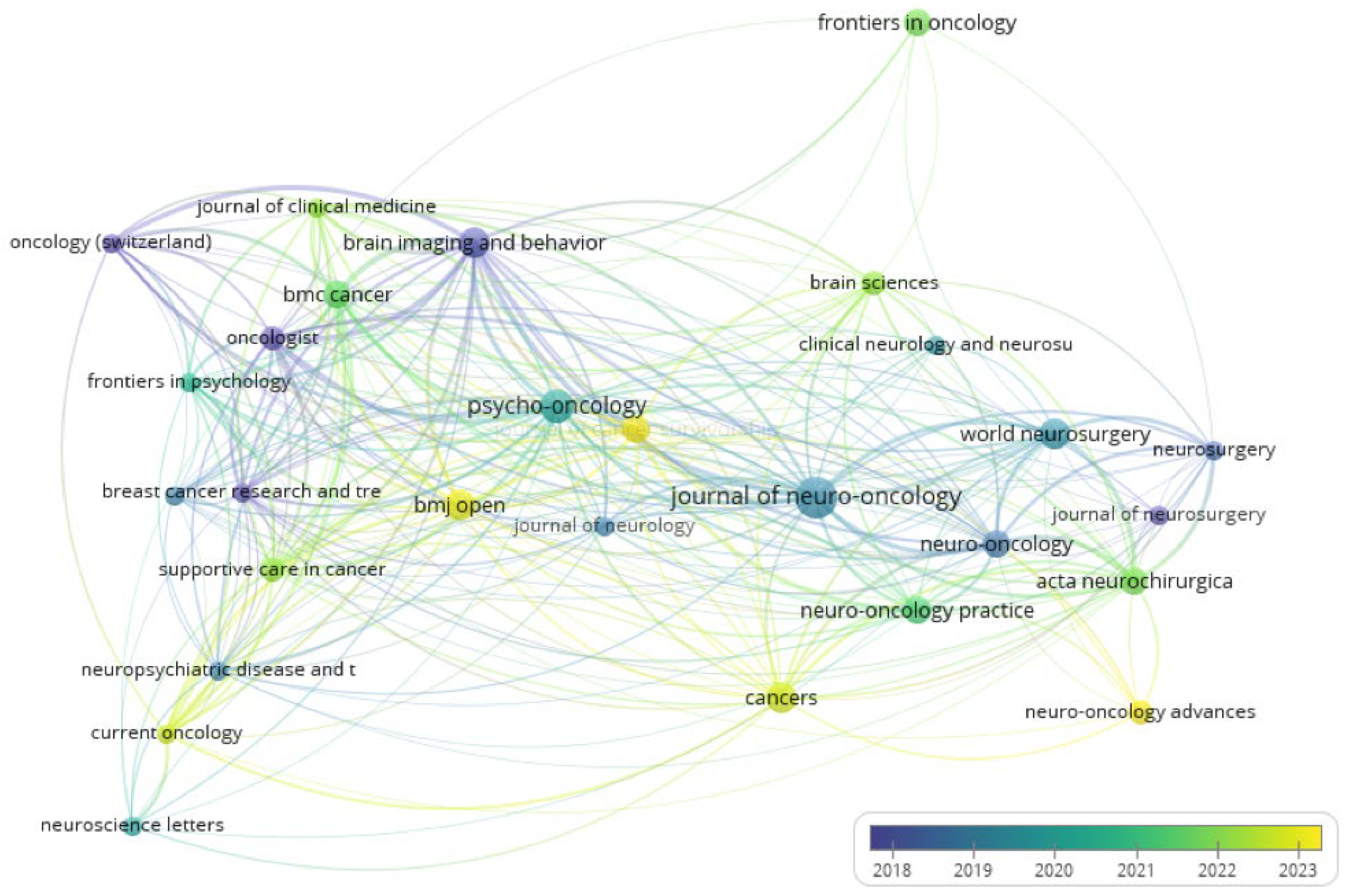
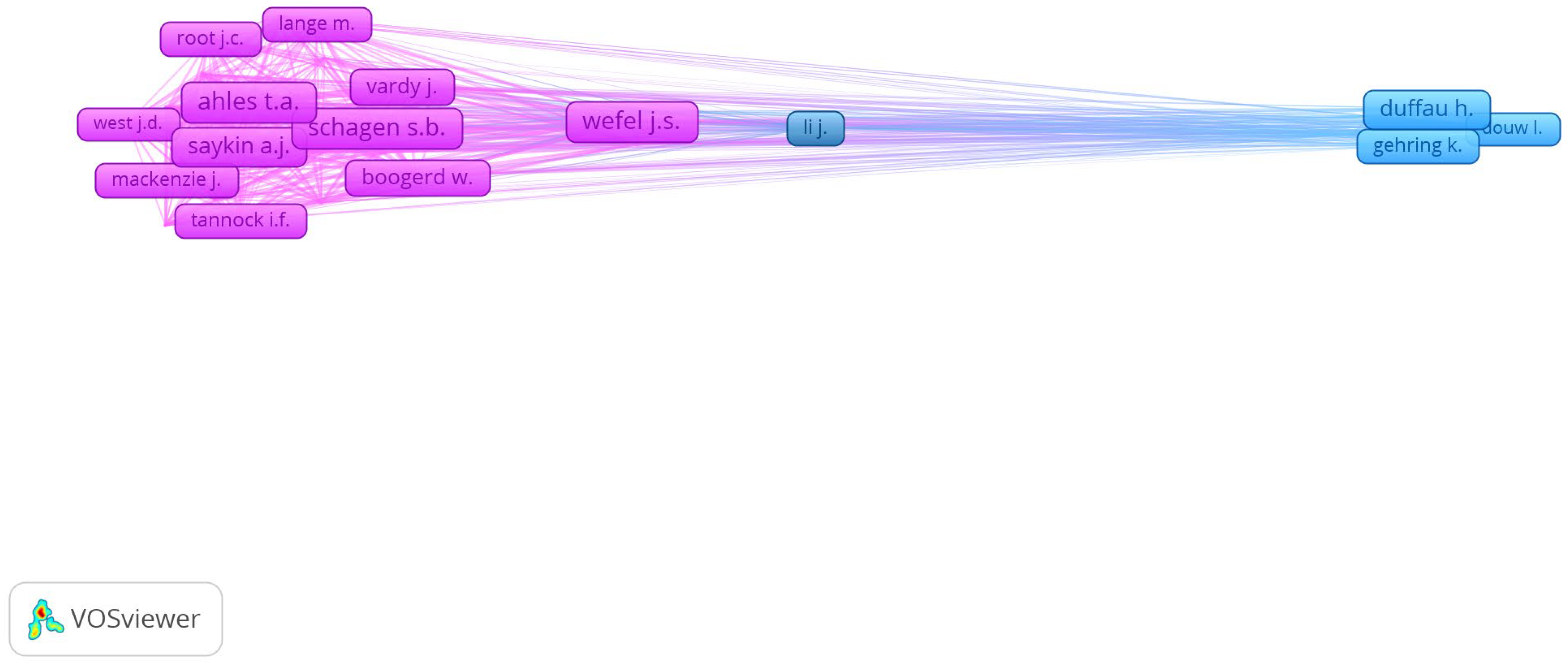
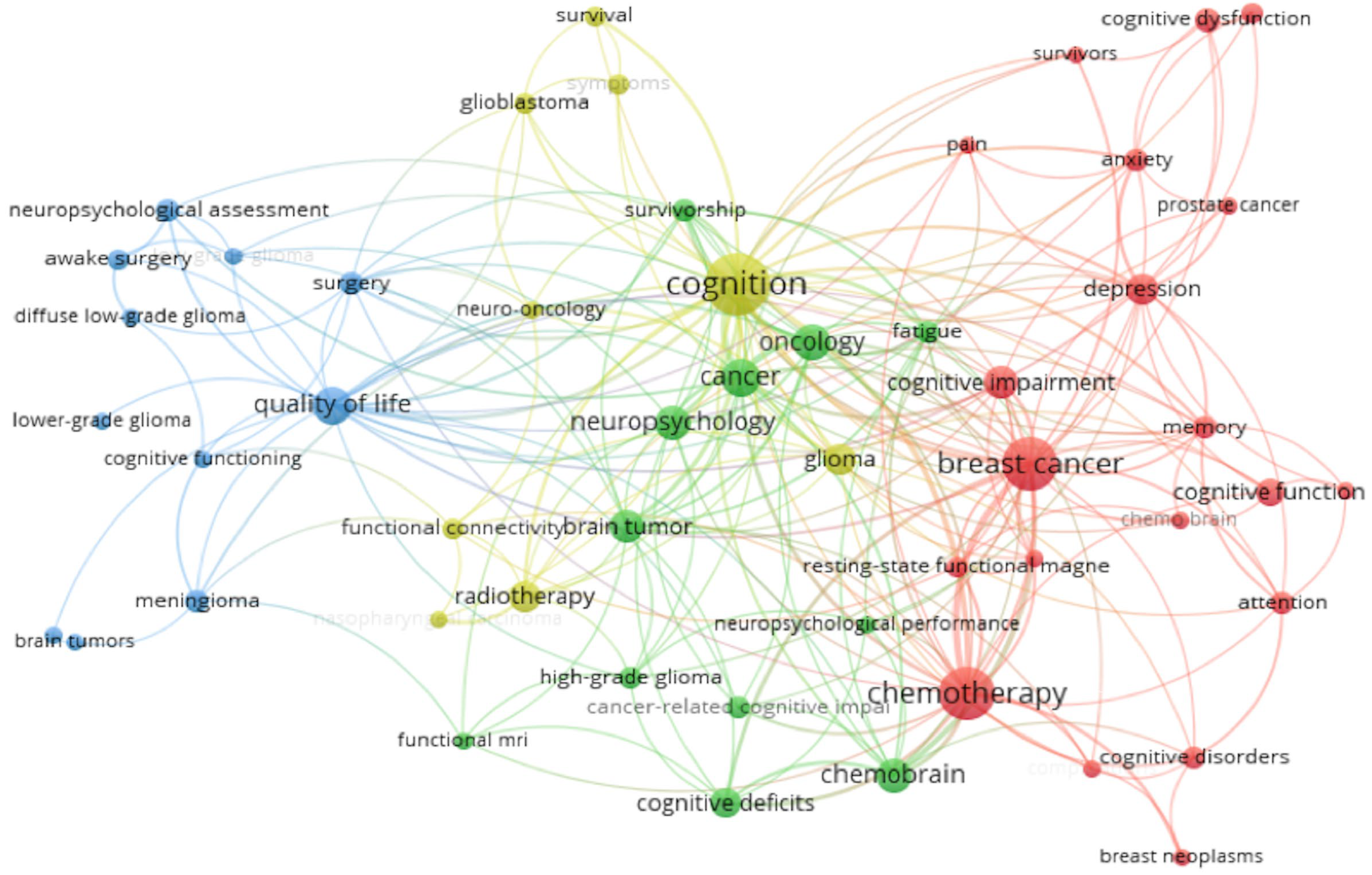
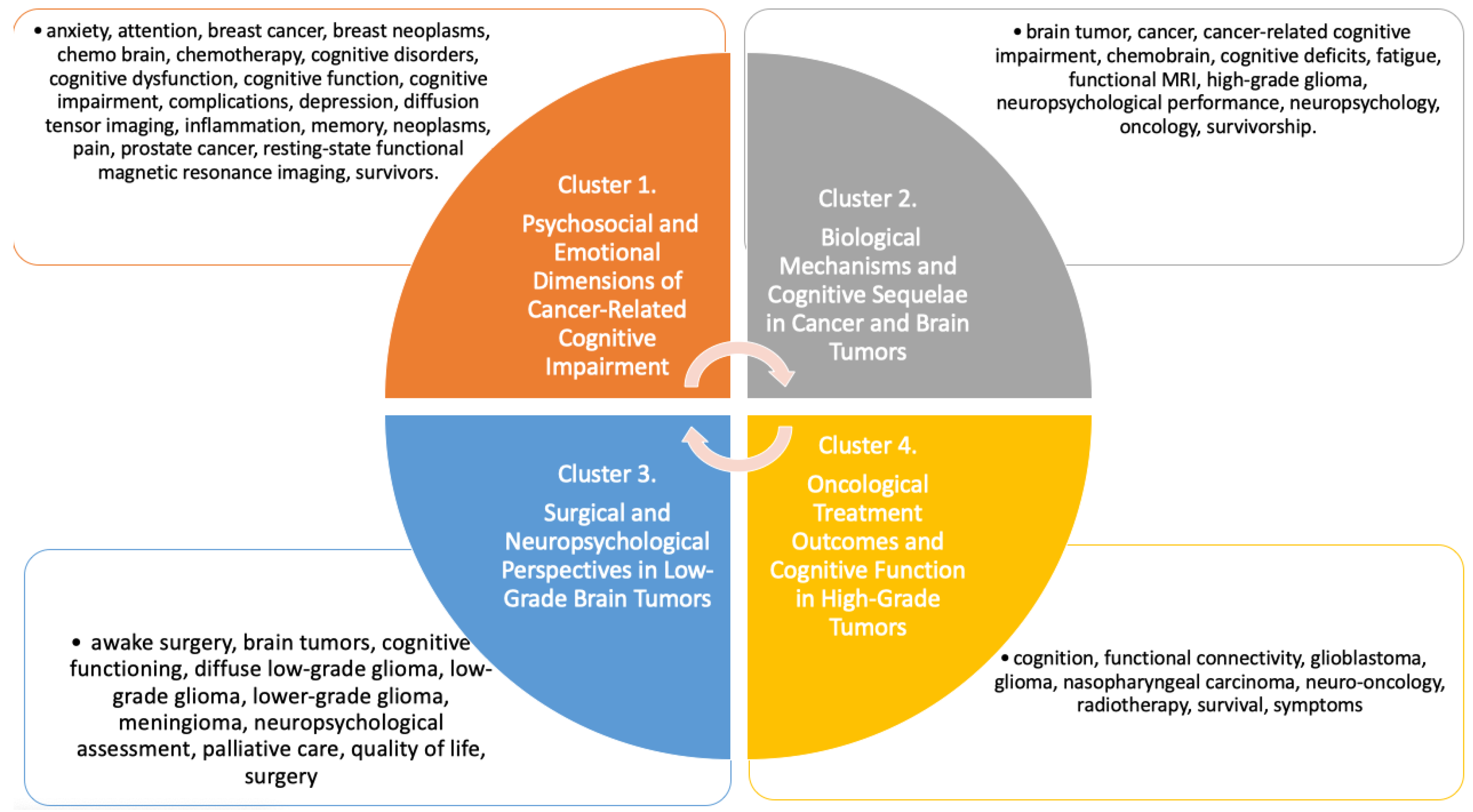
| Inclusion Criteria | Exclusion Criteria |
|---|---|
| Peer-reviewed journal articles | Articles involving animal models (e.g., rats) |
| Written in English | Articles written in languages other than English |
| Published between 2015 and 2025 | Case reports and Protocol papers |
| Focus on neuropsychological or cognitive deficits associated with cancer | Articles from non-academic sources (e.g., magazines, reports, conference abstracts) |
| Human adult populations | Studies involving children |
| Technique | Unit of Analysis | Minimum Threshold | Weight (Node Size) | Visualization Type |
|---|---|---|---|---|
| Co-authorship | Organizations | 2 documents | Number of documents | Network |
| Bibliographic Coupling | Sources | 2 documents | Number of documents | Overlay |
| Co-citation | Authors | 30 citations | Number of citations | Network |
| Co-occurrence | Author keywords | 3 occurrences | Number of keyword occurrences | Network |
| Author | Documents | Citations |
|---|---|---|
| Eustache, Francis | 5 | 151 |
| Giffard, Bénédicte | 5 | 151 |
| Joly, Florence | 5 | 151 |
| Rutten, Geert-Jan M. | 4 | 122 |
| Sitskoorn, Margriet M. | 4 | 191 |
| Araújo-Soares, Vera | 4 | 23 |
| Burns, Richéal | 4 | 23 |
| Chen, Vincent Chin-Hung | 4 | 43 |
| Dutton, Lizzie | 4 | 23 |
| Finch, Tracy | 4 | 23 |
| Gallagher, Pamela | 4 | 23 |
| Lewis, Joanne | 4 | 23 |
| Rimmer, Ben | 4 | 23 |
| Sharp, Linda | 4 | 23 |
| Williams, Sophie | 4 | 23 |
| Source | Documents | Citations |
|---|---|---|
| Journal of Neuro-Oncology | 9 | 194 |
| Psycho-Oncology | 6 | 99 |
| Brain Imaging and Behavior | 5 | 132 |
| World Neurosurgery | 5 | 86 |
| BMJ Open | 5 | 9 |
| Cancers | 5 | 32 |
| BMC Cancer | 4 | 32 |
| Acta Neurochirurgica | 4 | 89 |
| Neuro-Oncology | 4 | 234 |
| Neuro-Oncology Practice | 4 | 84 |
| Frontiers in Oncology | 4 | 50 |
| Journal of Cancer Survivorship | 4 | 20 |
| Oncologist | 3 | 141 |
| Neuro-Oncology Advances | 3 | 14 |
| Brain Sciences | 3 | 18 |
| Supportive Care in Cancer | 3 | 18 |
Disclaimer/Publisher’s Note: The statements, opinions and data contained in all publications are solely those of the individual author(s) and contributor(s) and not of MDPI and/or the editor(s). MDPI and/or the editor(s) disclaim responsibility for any injury to people or property resulting from any ideas, methods, instructions or products referred to in the content. |
© 2025 by the authors. Licensee MDPI, Basel, Switzerland. This article is an open access article distributed under the terms and conditions of the Creative Commons Attribution (CC BY) license (https://creativecommons.org/licenses/by/4.0/).
Share and Cite
Tsiakiri, A.; Despoti, A.; Koutsimani, P.; Megari, K.; Plakias, S.; Tsapanou, A. Mapping Cognitive Oncology: A Decade of Trends and Research Fronts. Med. Sci. 2025, 13, 191. https://doi.org/10.3390/medsci13030191
Tsiakiri A, Despoti A, Koutsimani P, Megari K, Plakias S, Tsapanou A. Mapping Cognitive Oncology: A Decade of Trends and Research Fronts. Medical Sciences. 2025; 13(3):191. https://doi.org/10.3390/medsci13030191
Chicago/Turabian StyleTsiakiri, Anna, Akyllina Despoti, Panagiota Koutsimani, Kalliopi Megari, Spyridon Plakias, and Angeliki Tsapanou. 2025. "Mapping Cognitive Oncology: A Decade of Trends and Research Fronts" Medical Sciences 13, no. 3: 191. https://doi.org/10.3390/medsci13030191
APA StyleTsiakiri, A., Despoti, A., Koutsimani, P., Megari, K., Plakias, S., & Tsapanou, A. (2025). Mapping Cognitive Oncology: A Decade of Trends and Research Fronts. Medical Sciences, 13(3), 191. https://doi.org/10.3390/medsci13030191








